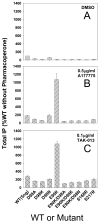Trafficking and quality control of the gonadotropin releasing hormone receptor in health and disease
- PMID: 19059461
- PMCID: PMC2655134
- DOI: 10.1016/j.mce.2008.10.051
Trafficking and quality control of the gonadotropin releasing hormone receptor in health and disease
Abstract
In order to serve as enzymes, receptors and ion channels, proteins require structural precision. This is monitored by a cellular quality control system (QCS) that rejects misfolded proteins and thereby protects the cell against aberrant activity. Misfolding can result in protein molecules that retain intrinsic function, yet become misrouted within the cell; these cease to perform normally and result in disease. A therapeutic opportunity exists to correct misrouting and rescue mutants using "pharmacoperones" (small molecular folding templates, often peptidomimetics, which promote correct folding and rescue) thereby restoring function and potentially curing the underlying disease. Because of its small size, the GnRH (gonadotropin-releasing hormone) receptor (GnRHR) is an excellent model for GPCR (G protein-coupled receptor) and has allowed elucidation of the precise biochemical mechanism of pharmacoperone action necessary for rational design of new therapeutic agents. This review summarizes what has been learned about the structural requirements of the GnRHR that govern its interaction with the QCS and now presents the potential for the rational design of pharmacoperones. Because of the role of protein processing, this approach is likely to be applicable to other GCPCs and other proteins in general.
Figures





Similar articles
-
Drug development and the cellular quality control system.Trends Pharmacol Sci. 2009 May;30(5):228-33. doi: 10.1016/j.tips.2009.02.002. Epub 2009 Mar 21. Trends Pharmacol Sci. 2009. PMID: 19307028 Review.
-
G protein-coupled receptor trafficking in health and disease: lessons learned to prepare for therapeutic mutant rescue in vivo.Pharmacol Rev. 2007 Sep;59(3):225-50. doi: 10.1124/pr.59.3.2. Pharmacol Rev. 2007. PMID: 17878512 Review.
-
Restoration of testis function in hypogonadotropic hypogonadal mice harboring a misfolded GnRHR mutant by pharmacoperone drug therapy.Proc Natl Acad Sci U S A. 2013 Dec 24;110(52):21030-5. doi: 10.1073/pnas.1315194110. Epub 2013 Dec 9. Proc Natl Acad Sci U S A. 2013. PMID: 24324164 Free PMC article.
-
Trafficking of G-protein-coupled receptors to the plasma membrane: insights for pharmacoperone drugs.Trends Endocrinol Metab. 2010 Mar;21(3):190-7. doi: 10.1016/j.tem.2009.11.003. Epub 2009 Dec 11. Trends Endocrinol Metab. 2010. PMID: 20005736 Free PMC article. Review.
-
Therapeutic rescue of misfolded mutants: validation of primary high throughput screens for identification of pharmacoperone drugs.PLoS One. 2011;6(7):e22784. doi: 10.1371/journal.pone.0022784. Epub 2011 Jul 27. PLoS One. 2011. PMID: 21818389 Free PMC article.
Cited by
-
Common α2A and α2C adrenergic receptor polymorphisms do not affect plasma membrane trafficking.Naunyn Schmiedebergs Arch Pharmacol. 2014 Jun;387(6):569-579. doi: 10.1007/s00210-014-0972-6. Epub 2014 Mar 19. Naunyn Schmiedebergs Arch Pharmacol. 2014. PMID: 24643471 Free PMC article.
-
Transitioning pharmacoperones to therapeutic use: in vivo proof-of-principle and design of high throughput screens.Pharmacol Res. 2014 May;83:38-51. doi: 10.1016/j.phrs.2013.12.004. Epub 2013 Dec 25. Pharmacol Res. 2014. PMID: 24373832 Free PMC article. Review.
-
Pharmacological chaperoning: a primer on mechanism and pharmacology.Pharmacol Res. 2014 May;83:10-9. doi: 10.1016/j.phrs.2014.01.005. Epub 2014 Feb 14. Pharmacol Res. 2014. PMID: 24530489 Free PMC article. Review.
-
Normosmic congenital hypogonadotropic hypogonadism due to TAC3/TACR3 mutations: characterization of neuroendocrine phenotypes and novel mutations.PLoS One. 2011;6(10):e25614. doi: 10.1371/journal.pone.0025614. Epub 2011 Oct 21. PLoS One. 2011. PMID: 22031817 Free PMC article.
-
The Novel Actions of the Metabolite GnRH-(1-5) are Mediated by a G Protein-Coupled Receptor.Front Endocrinol (Lausanne). 2013 Jul 8;4:83. doi: 10.3389/fendo.2013.00083. eCollection 2013. Front Endocrinol (Lausanne). 2013. PMID: 23847594 Free PMC article.
References
-
- Amaral MD. Therapy through chaperones: sense or antisense? Cystic fibrosis as a model disease. J Inherit Metab Dis. 2006;29:477–87. - PubMed
-
- Andersson H, D’Antona AM, Kendall DA, Von Heijne G, Chin CN. Membrane assembly of the cannabinoid receptor 1: impact of a long N-terminal tail. Mol Pharmacol. 2003;64:570–7. - PubMed
-
- Aridor M. Visiting the ER: the endoplasmic reticulum as a target for therapeutics in traffic related diseases. Adv Drug Deliv Rev. 2007;59:759–81. - PubMed
-
- Benedek GB, Pande J, Thurston GM, Clark JI. Theoretical and experimental basis for the inhibition of cataract. Prog Retin Eye Res. 1999;18:391–402. - PubMed
-
- Bernier V, Bichet DG, Bouvier M. Pharmacological chaperone action on G-protein-coupled receptors. Curr Opin Pharmacol. 2004a;4:528–33. - PubMed
Publication types
MeSH terms
Substances
Grants and funding
LinkOut - more resources
Full Text Sources

